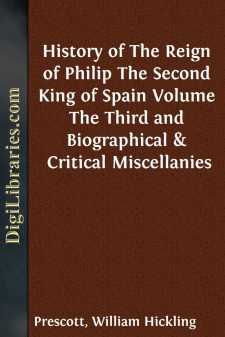Categories
- Antiques & Collectibles 13
- Architecture 36
- Art 48
- Bibles 22
- Biography & Autobiography 813
- Body, Mind & Spirit 142
- Business & Economics 28
- Children's Books 14
- Children's Fiction 11
- Computers 4
- Cooking 94
- Crafts & Hobbies 4
- Drama 346
- Education 46
- Family & Relationships 57
- Fiction 11829
- Games 19
- Gardening 17
- Health & Fitness 34
- History 1377
- House & Home 1
- Humor 147
- Juvenile Fiction 1873
- Juvenile Nonfiction 202
- Language Arts & Disciplines 88
- Law 16
- Literary Collections 686
- Literary Criticism 179
- Mathematics 13
- Medical 41
- Music 40
- Nature 179
- Non-Classifiable 1768
- Performing Arts 7
- Periodicals 1453
- Philosophy 64
- Photography 2
- Poetry 896
- Political Science 203
- Psychology 42
- Reference 154
- Religion 513
- Science 126
- Self-Help 84
- Social Science 81
- Sports & Recreation 34
- Study Aids 3
- Technology & Engineering 59
- Transportation 23
- Travel 463
- True Crime 29
History of the Reign of Philip the Second, King of Spain, Vols. 1 and 2
Description:
Excerpt
The reign of Philip the Second has occupied the pen of the historian more frequently—if we except that of Charles the Fifth—than any other portion of the Spanish annals. It has become familiar to the English reader through the pages of Watson, who has deservedly found favor with the public for the perspicuity of his style,—a virtue, however, not uncommon in his day,—for the sobriety of his judgments, and for the skill he has shown in arranging his complicated story, so as to maintain the reader's interest unbroken to the end. But the public, in Watson's day, were not very fastidious in regard to the sources of the information on which a narrative was founded. Nor was it easy to obtain access to those unpublished documents which constitute the best sources of information. Neither can it be denied that Watson himself was not so solicitous as he should have been to profit by opportunities which a little pains might have put within his reach,—presenting, in this respect, a contrast to his more celebrated predecessor, Robertson; that he contented himself too easily with such cheap and commonplace materials as lay directly in his path; and that, consequently, the foundations of his history are much too slight for the superstructure. For these reasons, the reign of Philip the Second must still be regarded as open ground for English and American writers.
And at no time could the history of this reign have been undertaken with the same advantages as at present, when the more enlightened policy of the European governments has opened their {iv}national archives to the inspection of the scholar; when he is allowed access, in particular, to the Archives of Simancas, which have held the secrets of the Spanish monarchy hermetically sealed for ages.
The history of Philip the Second is the history of Europe during the latter half of the sixteenth century. It covers the period when the doctrines of the Reformation were agitating the minds of men in so fearful a manner as to shake the very foundations of the Romish hierarchy in the fierce contest which divided Christendom. Philip, both from his personal character, and from his position as sovereign of the most potent monarchy in Europe, was placed at the head of the party which strove to uphold the fortunes of the ancient Church; and thus his policy led him perpetually to interfere in the internal affairs of the other European states,—making it necessary to look for the materials for his history quite as much without the Peninsula as within it. In this respect the reign of Ferdinand and Isabella presents a strong contrast to that of Philip the Second; and it was the consideration of this, when I had completed my history of the former, and proposed at some future day to enter upon that of the latter, that led me to set about a collection of authentic materials from the public archives in the great European capitals. It was a work of difficulty; and, although I had made some progress in it, I did not feel assured of success until I had the good fortune to obtain the coöperation of my friend, Don Pascual de Gayangos, Professor of Arabic in the University of Madrid. This eminent scholar was admirably qualified for the task which he so kindly undertook; since, with a remarkable facility—such as long practice only can give—in deciphering the mysterious handwriting of the sixteenth century, he combined such a thorough acquaintance with the history of his country as enabled him to detect, amidst the ocean of manuscripts which he inspected, such portions as were essential to my purpose.
With unwearied assiduity he devoted himself to the examination of many of the principal collections, both in England and on the Continent. Among these may be mentioned the British Museum and the State-Paper Office, in London; the Library of the Dukes of Burgundy, in Brussels; that of the University of Leyden; the {v}Royal Library, at the Hague; the Royal Library of Paris, and the Archives of the Kingdom, in the Hôtel Soubise; the Library of the Academy of History, the National Library at Madrid, and, more important than either, the ancient Archives of Simancas, within whose hallowed precincts Señor Gayangos was one of the first scholars permitted to enter.
Besides these public repositories, there are several private collections to the owners of which I am largely indebted for the liberal manner in which they have opened them for my benefit....







